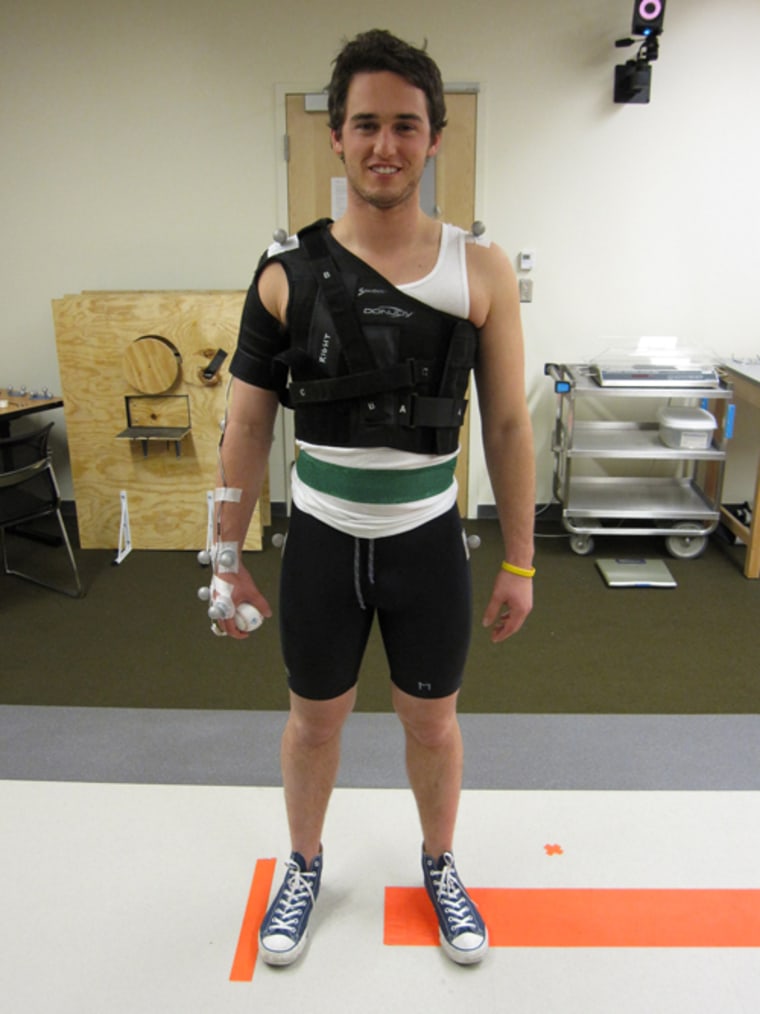
Johan Santana of the New York Mets, the highest-paid pitcher in major league baseball, took home a salary of $23 million in 2012. Two million years before him, the very first human throwers probably also used their shoulders to bring home the bacon, flinging sharpened rocks or spears to hunt down game.
Unlike our closest primate cousins, the chimpanzees, humans can throw fast. Highly trained pitchers and cricket bowlers can hurl balls at speeds up to 100 miles per hour. To figure out when our bodies first became pitching machines, experts on biomechanics studied the pitching movements of college baseball players, and pinned down the uniquely human body parts that allow people like Santana to throw like pros. Neil Roach, a post-doctoral researcher at George Washington University, and his colleagues explain their findings in Thursday's issue of Nature.
The human throwing mechanism works like a rubber-band, storing elastic energy in tendons and ligaments in the shoulder and then releasing it in a burst, the researchers found. The slinging shoulder is the fastest movement the human body can perform, and one of a handful of physical tasks that humans can do better than other animals (long-distance running is another).

The human body is one big elastic slingshot, said Madhusudan Venkadesan, an assistant professor at the National Center for Biological Sciences in Bangalore, India, and a contributor to the study. The act of throwing engages muscles in the legs, waist, hips, shoulders, elbows and wrist. By two million years ago, Homo erectus had developed the ability to transmit energy from the big muscles around the waist all the way to the tip of the arms.
Being able to throw objects — perhaps rocks or sharpened spears — to hunt small animals would have had a tremendous benefit: the added calories would have supported a bigger brain. In modern humans the organ is a notorious energy hog, sucking up 20 percent of the body's energy. "You had to eat the brains of other animals for our brains to grow bigger," Venkadesan said.
Roach, who worked on this project as part of his Ph.D. thesis at Harvard University, enlisted 20 Harvard baseball players, and then tracked and analyzed their pitching moves. After watching their best shots, Roach and team shifted the players’ bodies onto another branch of the evolutionary tree: With sports medicine braces, they strapped down their shoulders and arms to mimic a chimpanzee's body structure. The researchers then compared their throwing motions with their freer technique.
Three key changes in the bodies of Homo erectus (as they stood up and walked) allowed humans to start throwing, the authors concluded. Their waists got longer, which allowed the torso to rotate independently of the hips. The shoulders dropped, taking a more relaxed stance compared to the shrugged shoulders of our primate relatives. And the humerus, the long bone of the upper forearm, became capable of swift twisting motion.
When all the factors came together, lead author Neil Roach said during a teleconference, "It allowed the muscle to act almost like a whip."
Though the new work shows that humans' bodies were built to start throwing things, hunting tools don’t appear much later in the archaeological record. Daniel Schmitt, a professor of evolutionary anthropology at Duke University, says it's "very cool" that Roach and his colleagues put together the picture of Homo erectus as a thrower, but he continues to wonder: "If they could throw, what was it they were throwing?"
The reason he's "lukewarm on the idea they were throwing anything," he told NBC News, is because Homo erectus didn't have many tools other than the sharp but rock-solid hand-axe. Compared to that, later species like "Neanderthals, for being as ugly as they were, had a pretty big tool set." Later still, "modern humans 10,000 years ago had amazing things, harpoons and needles," Schmitt said.
In the next chapter of their investigation, Roach and the team will look at how the mechanics of throwing can change with the tools that are used, to better understand what early humans were using in their throws.
More about throwing:
- GWU video about the mechanics of throwing
- Neanderthals lacked projectile weapons
- Chimp plots to throw things at humans
In addition to Neil Roach and Madhusudhan Venkadesan, the authors of "Elastic Energy Storage in the Shoulder and the Evolution of High-Speed Throwing in Homo" include Michael Rainbow of Harvard Medical School and Daniel Lieberman of Harvard. This report was updated at 3:15 p.m. June 27 to reflect the fact that the research was conducted while Roach was at Harvard.
Nidhi Subbaraman writes about science and technology. Follow her on Facebook, Twitter and Google+.
